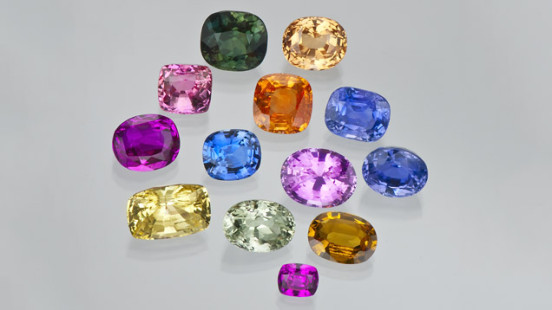Many societies throughout history have elevated the color blue above almost any other. Royalty in the Ancient Near and Middle East wore blue. Hindu deities were often depicted in various shades of blue. Persians believed the Earth rested on a giant sapphire, the reflection of which colored the sky. The Pharaohs of Ancient Egypt were buried in sarcophagi of gold and blue. In Judaism, blue represents a deep-seated train of thought that leads one’s mind from the sea to the sky to God’s Throne of Glory.
It’s no wonder that when a transparent blue gemstone of significant durability was unearthed, it was snatched up by the cultural elite and elevated like few other things have been. Sapphires were most likely originally discovered in India, Burma, and/or Sri Lanka. They were found as tumbled pebbles in riverbeds where they had washed down from higher up in the mountains.
The gemstones we now know as sapphires were not well known to any culture west of what is now Pakistan for a very long time. The earliest would have been after Media-Persia conquered what is now Afghanistan and Pakistan in the 6th Century BC. The latest would likely be the Indian Campaign of Alexander the Great two hundred years later.
Either way, once the budding Western Civilization got a hold of sapphires, they most likely considered them just another color variety of hyakinthinos (Latinized as “jacinth”): a fairly generic name for any hard, transparent gemstone that was red, blue, or purple. The Greek word “sappheiros” is where we get the modern term “sapphire,” but “sappheiros” most likely referred to lapis lazuli, which the Greeks had known for centuries. It wasn’t until the Romans came into power that we can confirm corundum sapphire gained its own recognition in Western Society.
But sapphire still didn’t get its due acclaim until the 12th Century AD. The Catholic clergymen of that day thought the pure blues were direct reflections of Heaven, and the color’s association with the Deification of Christ reinforced the notion. In lieu of this, sapphires were believed to ward off demons, instill faithfulness, and protect a person from being lied to. When the Bishop of Rennes became so fascinated with sapphire that he declared it to be the “gem of gems,” its popularity as the center of ecclesiastical rings became solidified.
Today, blue sapphires are all the rage. The engagement ring Prince Charles of the United Kingdom gave to Lady Diana Spencer in the early 1980s really stacked the deck for sapphires, and soon everyone wanted a “Lady Di” ring. The effect had a major resurgence when Prince William presented Lady Kate Middleton with a similar ring in 2010. The fact that sapphire is the birthstone for September only adds to its popularity.
But sapphires aren’t all about blue. In fact, some of them are about red, but you know them by another name: ruby. Sapphire and ruby are the classical names for the mineral corundum. Rubies are red corundum, and sapphires are all other colors. Corundum naturally forms in every color, depending on the elemental impurities present during its formation: so mandarin oranges, canary yellows, forest greens, and bubble gum pinks are all natural occurrences. The etymology of “sapphire” specifically connotes blue, so any corundum that is not blue or red is deemed a “fancy color,” and its hue is used as a designation: i.e. pink sapphire, green sapphire, purple sapphire, etc.

Photographed for the CIBJO project from the Dr. Eduard J. Gubelin Collection.
Apart from their extensive color palate, sapphires are robust gems, as well. They are perfectly suited to use in all types of jewelry both because of their hardness and their toughness. The list of natural materials that are harder than corundum can be ticked off on one hand: diamond and the extremely rare natural moissanite. Regarding toughness (resistance to chipping or breaking), the only gems classified as tougher than corundum are jadeite and nephrite. Sapphires don’t cleave like diamonds, nor are they prone to chipping or cracking like emeralds, so they make an excellent choice for an everyday wear.
When shopping for fine sapphire, always search for the color that appeals the most to you, and be on the lookout for eye-clean stones. You have virtually the whole palate from which to choose (except red, because then you’d be shopping for rubies).
Color and clarity in a sapphire may be misleading, however. Heat treatment has become the industry standard for sapphires, even in fine grades. It is usually done to the rough material at the mine. Heating sapphire intensifies color, especially in warmer tones like orange, yellow, and pink. It also dissolves internal inclusions, thus improving the clarity of the material.
Certified untreated sapphire is available, and I’m happy to find it for you, but it will usually come with a premium for the paperwork. Untreated sapphire in a jewelry store is rather unusual, so unless the individual sapphire you’re looking at is certified as natural and untreated, assume that it has undergone some form of treatment. There’s no shame in owning a treated sapphire, so long as you think it is beautiful, and you would appreciate wearing it. That’s what’s most important about a piece of jewelry.
Tags: clarity, diamonds, gemstones, jewelry, popularity, ruby, sapphires, september birthstone